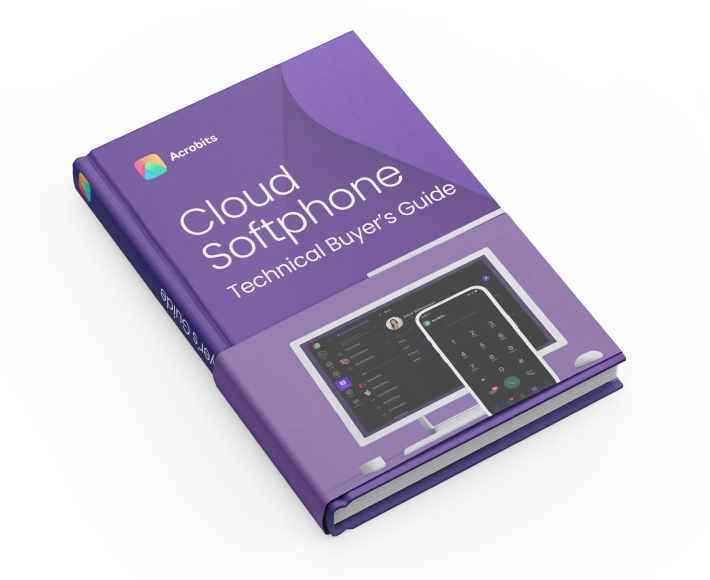
First things first:
Communications Platform as a Service (CPaaS) is a cloud-based service model that allows businesses to add real-time communication features to their own applications or websites without needing to build backend infrastructure and interfaces.
It allows you to add real-time communication (RTC) tools to your business applications and networks. Like many other “as a Service” products, CPaaS is a business platform delivered over the cloud.
By providing APIs and SDKs, developers can seamlessly integrate UCaaS capabilities, streamlining the process of enhancing customer and team interactions without requiring a separate application.
It’s like adding a chat box on a website to talk to customers in real time, without needing to create a whole new app for it.
Companies today outsource many of their tools and operations to third parties, hence why Software-as-a-Service, Infrastructure-as-a-Service, and Platform-as-a-Service have become common terms in business lingo.
With all the “as a Service” terms flying around, it can be easy to lose track of the specific solutions you need.
But one that makes sense in almost all cases is a CPaaS. What is it; how does it work; and why should you care?
Because CPaaS vendors sell you fully supported frameworks, there’s no need to build any backend infrastructure on your part, and you don’t need any technical expertise to get the most out of the platform.
That’s why CPaaS has become popular with small and developing organizations, who now have access to collaboration tools that were previously exclusive to larger enterprises. In fact, CPaaS is one of the fastest-growing communication industries today.
CPaaS (Communication Plarform as a Service) is made possible thanks to communication APIs. These sets of rules allow different software pieces to communicate with each other. These APIs enable real-time communication features like chat, voice, and video to be added into existing apps and websites.
APIs often use Voice over IP (VoIP) networks behind the scenes to transfer data packets from one point to another.
CPaaS providers offer these communication APIs as a service. Businesses can choose which features they want to add to their apps or websites, such as text messaging or video calls. They integrate these features using the provided APIs and pay the CPaaS provider a subscription fee.

This model saves businesses from the complexity and cost of developing and maintaining these communication technologies themselves, while also providing support and maintenance as part of the service.
The main idea here is that you won’t have to invest in your own CPaaS infrastructure. A third-party service provider integrates the right features into your software through:
This way, you have a customizable solution where novel features can be added as necessary. Client businesses can expand the capabilities of their own networks while still maintaining basic on-site functions.
But you don’t have to worry about how it all works. A CPaaS solution provider will give you the full framework to get started. If you have any issues, you can rely on its technical support. And all of these services are provided for only a simple subscription-based fee.
CPaaS, or Communications Platform as a Service, is leveraged by businesses across various sectors to enhance and streamline their communication processes, both internally and with customers.
Its flexibility and comprehensive API suite make it a powerful tool for a myriad of applications:
In essence, CPaaS is utilized to create more efficient, secure, and personalized communication experiences both within organizations and between businesses and their customers, adapting to the unique needs of each industry to improve operations, customer engagement, and security.
Your workplace might already be using CPaaS even though you might not know it yet.
The CPaaS market has grown in recent years, largely driven by recent business trends like the desire to boost the customer experience. For example:
Communication is such a universal business process that you might find your own creative use case after adopting a CPaaS platform.
Both CPaaS and UCaaS (Unified Communications as a Service) providers deliver cloud-based communication services to their business clients, but there are a few subtle but important distinctions between the industries:
| Feature | CPaaS | UCaaS |
|---|---|---|
| Customization | Extensive: Offers granular control over features and integration. | Moderate: Provides customization within a predefined range of options. |
| Development Effort | Higher: Requires technical expertise for API integration and custom coding. | Lower: Offers out-of-the-box solutions that can be deployed with minimal customization. |
| Scalability | Excellent: Can easily scale up or down based on specific project or business needs. | Very Good: Scalable to a large extent but within the framework of the provided platform. |
| Integration Flexibility | Superior: Easily integrates with existing apps and infrastructure for tailored solutions. | Good: Integrates with standard business tools, but with less flexibility compared to CPaaS. |
| Deployment Speed | Variable: Depends on the complexity of the integration and customization. | Faster: Quicker deployment due to pre-built features and streamlined setup. |
| Ideal for | Businesses needing tailor-made communication features | Businesses looking for an all-in-one communication platform |
| Cost Implication | Variable: Costs can increase with the level of customization and scalability required. | Predictable: Typically offers a fixed subscription model, making costs easier to forecast. |
| Technical Support | Comprehensive: Provides in-depth support tailored to custom implementations. | Standard: Offers general support for the platform, sufficient for most needs. |
CPaaS, as described, uses APIs to integrate new features into a business’s pre-existing communication system.
UCaaS consolidates all the collaboration tools into a single platform that the vendor sells in its entirety to the client.
You can’t integrate UCaaS into an existing application like you can with CPaaS but rather use it alongside your current technology stack.
Which one works best for you? It depends on your specific circumstances. If you want a straightforward, complete package for all your collaboration needs, UCaaS would make sense.
But if you need specific features without switching over entirely to an external service and need the additional flexibility of integrations with your existing internal systems, CPaaS is the way to go.
CPaaS, or Communications Platform as a Service, revolutionizes how businesses communicate, offering a blend of flexibility, scalability, and cost-efficiency that traditional communication solutions can’t match. Here’s a comprehensive look at the benefits it brings to the table:
With pre-built APIs, CPaaS enables quick integration of communication features like messaging and video into apps and websites, allowing businesses to innovate and respond to market demands rapidly.
By leveraging the cloud and a pay-as-you-go model, CPaaS eliminates the need for expensive on-premises equipment and allows businesses to pay only for what they use. This approach leads to significant savings in setup and operational costs. Additionally, features like automated appointment reminders and support chatbots help reduce operational costs further.
CPaaS empowers businesses to offer personalized engagement through various channels like text, voice, and video. Personalized interactions, such as digital coupons and live chat support, enhance customer satisfaction and loyalty.
Enhancing communication security, CPaaS offers tools like two-factor authentication and instant fraud alerts, helping businesses protect customer information and build trust.
The use of APIs facilitates the swift development and deployment of new communication features, making CPaaS setups ready to use within days, not weeks or months.
CPaaS provides a customizable communication solution tailored to specific business needs, whether it’s integrating certain communication types or scaling features up or down, ensuring a perfect fit for any business model.
CPaaS can easily adjust to handle varying levels of demand, allowing businesses to scale their communication capabilities as they grow, ensuring they can always meet their customers’ needs without overextending resources.
CPaaS seamlessly integrates with existing applications, maintaining app integrity and enriching user experience without requiring a complete overhaul.
Real-time communication capabilities foster a more direct and efficient connection with clients, enhancing customer service and engagement without the friction of traditional contact methods.
The cloud-based, subscription-based model of CPaaS replaces the need for in-house development and maintenance of communication infrastructure, offering a cost-effective alternative that scales with business needs.

CPaaS stands as a transformative solution for businesses aiming to streamline their communications, reduce costs, and offer a more personalized and secure experience to their customers.
Its scalable, customizable nature ensures it can adapt to any business size or type, making it a versatile and indispensable tool in today’s digital landscape.
As with all in life, there’s always a bad side to everything. Let’s explore what are the most common contras of CPaaS:
CPaaS challenges include complex integration for beginners, reliance on providers risking disruptions, escalating costs with increased usage, limited customization for unique needs, security concerns with sensitive data, and potential issues with provider support and service reliability.
| CPaaS Function | Description | Use Cases |
|---|---|---|
| Outbound Voice Calls | Enables outgoing calls through a Voice API, allowing scalability in calling capacity. | Adaptive response to call volume changes. |
| Inbound Call Routing | Utilizes webhooks for routing incoming calls as per predefined instructions, streamlining call management. | Efficient handling of incoming calls. |
| WebRTC-based Calling | Offers real-time communication in browsers and apps through voice and video communication features like conferencing and encryption. | Enhancing web and app communication. |
| Text Messaging (SMS) | Supports sending notifications, alerts, and two-way messaging from your business number, with functionality for group messages and delivery tracking. | Communication with customers and teams. |
| On-demand SIP Trunking | Provides flexible connectivity for IP-based communications, allowing easy scalability of call capacity. | Scaling communication infrastructure. |
| Multimedia & Video Messaging (MMS) | Supports sending and receiving media through SMS, varying by provider in terms of international support and media options. | Rich media communication. |
| Social Media Messaging | Integrates messaging across platforms like Facebook, X, and WhatsApp, enabling multimedia sharing, location sharing, and automated support. | Broadening communication channels. |
| Number Masking | Conceals actual phone numbers during calls, protecting customer privacy and ensuring safety. | Privacy protection in customer interactions. |
Alternatives to CPaaS include API Management for gradual integration, PaaS for custom apps, On-Premises for control, DIY for flexibility, Virtual Workspaces for team collaboration, SIP Trunks for VoIP benefits, CCaaS for call center focus, and UCaaS for all-in-one solutions.
There are many features and benefits to working with a CPaaS partner that make the nominal subscription fee worth the money.
Of course, these are just the well-known benefits experienced by many companies of all sizes. What CPaaS can do for you specifically is for you to discover.
Instead of using separate tools and services like FaceTime, WhatsApp, or even traditional telephony, there’s an alternate solution that involves adding those features to your infrastructure.
CPaaS service providers can deliver the entire framework to you and integrate via APIs and SDKs various functionalities like text messaging, video conferencing, authentication methods, and many more.
CPaaS is a cloud-based service enabling businesses to add real-time communication features to applications or websites without building backend infrastructure.
It offers APIs and SDKs for seamless integration of voice, chat, and video, fostering agility, cost savings, and enhanced customer experience.
Despite challenges like complex integration and dependence on providers, CPaaS’s scalability, customizability, and support make it a compelling choice for improving business communications.
Alternatives include UCaaS, CCaaS, SIP Trunks, and DIY platforms, each catering to different needs.
Ready to transform how your business communicates? Discover the power of Cloud Softphone, a cutting-edge platform designed to seamlessly integrate real-time communication features into your existing applications.
Whether you’re looking to enhance customer engagement, streamline internal operations, or secure your communications, Cloud Softphone offers the flexibility and reliability your business needs to stay ahead.
Don’t miss out on the opportunity to elevate your communication strategy. Book a demo today and see what Cloud Softphone can do for you. Let’s take your business communications to new heights together.

Even the most skilled employees can’t be productive if they can’t collaborate effectively with their peers and management teams. That’s why companies invest heavily in unified communication technologies that provide multi-channel communication platforms. What is a Multi-Channel Communication Platform? A multi-channel communication platform is a system designed to let users communicate using multiple channels. These […]

Our partners are the lifeblood of our business, and we are constantly striving to understand their needs to improve every aspect of our products and SDK. Since day one, Acrobits has taken pride in developing purpose-built solutions that cater to the unique needs of our partners, their industries, and their customers. Mobile Heartbeat has been […]

Microsoft completed an experiment using EEG monitoring devices to track people’s brain waves in remote and in-person meetings. Here’s what they discovered: • Virtual meetings lead to more stress and exhaustion than non-meeting work, such as writing emails • Remote collaboration is more overwhelming than in-person collaboration Virtual meeting fatigue is a physical, mental, and […]

Cookies will soon be a thing of the past. By 2024, third-party cookies will be phased out from nearly every major browser. And as noted by one analyst, Deloitte, we’re seeing an increasing push towards data ownership and data privacy, the reason your privacy and cookies policy can start clashing— a shift that arguably began […]